

Case Study:
Mt. Everest

Case Study:
Marine Exploration

Case Study/Video:
Red Bull Racing

Case Study:
Tablet PC at Beer Wholesaler

Tablet PC
Torture Chamber

|

|

|
|
|
MobileDemand xTablet T1185
Another rugged, well-conceived, and very practical 10-inch Windows tablets from one of the platform's leaders and early pioneers
by Conrad H. Blickenstorfer
Share on:



Tablets have undoubtedly revolutionized the way we use computers. Not as much as smartphones, but annual tablet sales are now massive any which way you look at it. In terms of numbers, in 2022, 163 million tablets (per Statista), 286 million laptops (also per Statista), and 1.21 billion smartphones (per IDC) were sold globally. Big business for sure.
Comparing tablets to laptops, of course, is comparing apples to oranges, because the two aren't generally used the same. But it's clear that the tablet form factor is here to stay. Tablets are light and handy, and they are increasingly deployed for work that used to be done on desktops and laptop. Iowa-based MobileDemand has been a tablet pioneer and big believer in tablets for many years, well before the iPhone and iPad first appeared. The company, a consistent innovator in the field, has been growing in leaps and bounds, and it's one of the few that exclusively focuses on rugged tablets. In this report we're examining one of MobileDemand's best-selling products, the xTablet T1185, and also show where it fits into the company's tablet lineup.
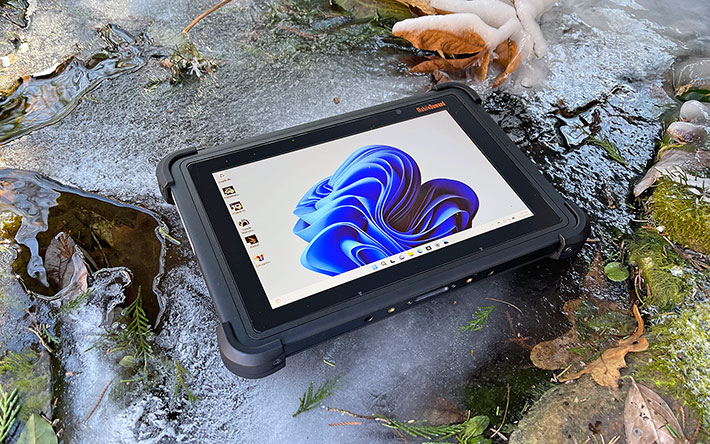
For a bit of MobileDemand's almost two decades' worth of history: the company initially built a business based on the use of fully rugged high-end tablets in a few specific vertical markets. They then branched out into more affordable tablets suitable for a wider variety of deployments. Product lineup strategies changed over the years, based on closely following productivity-enhancing technology trends, emerging and changing customer demands, and MobileDemand founder and visionary leader Matt Miller's openness to explore new tech and his ability to predict where things are going.
Over the years, MobileDemand has had device lineups with both smaller and larger models than is the case now. Today, the company sees their customer sweet spot in the 10-inch form factor, the same that Steve Jobs recognized as the optimal tablet size when the iPad was introduced, a size that's not too small and not too big.
Currently, at the low end is the economically priced "Flex" that prepackages a generic Windows tablet with a custom-designed protective case, briefcase handle, and scratch-proof screen protector. Above that are no fewer than five tablet with 10-inch screens, offerings with inherent ruggedness, sealing, and options geared towards vertical market deployments. These are book-ended by the 8-inch xTablet T8650 and the 11.6-inch xTablet T1690, both at this point updated legacy models that have been around for a good number of years. The picture below shows MobileDemand's Windows tablet lineup as of early 2023.

MobileDemand used to also have its own lineup of Android-based devices. There are none in this year's lineup. Instead, the company offers inexpensive Samsung and Lenovo Android tablets bundled with their protective xCases. xCases — which convert fragile consumer tablets into well-protected rugged ones — are also available for several Apple iPads and Microsoft Surface tablets.
Rounding out MobileDemand's offerings are software subscriptions and utilities, industrial strength power supply kits for tablet deployments in settings where periodic recharging isn't an option, as well as numerous productivity-enhancing tablet accessories.
With tablets, size and weight matter
Why the concentration on the 10-inch tablet class? Because it makes sense if that's the optimal size for a company's customers and industries served. And it makes sense to have several different tablets in the same size class because even within a class, customer requirements differ. Even Apple offers three different models in this class, with different features and performance levels. Sometimes, even relatively small differences in configurations, performance and price matter. So while MobileDemand found the 10-inch size to be the current sweet spot for its customers, the tablets they offer in this class are not the same. Below is a summary table that shows processors, size and weight of MobileDemand's current Windows tablet lineup:
|
xTablet Model
|
T8650
|
Flex 10B
|
T1110
|
T1180
|
T1185
|
T1190
|
T1690
|
|
Processor
|
Atom
x5-Z8550
|
Celeron
N4100
|
Pentium
N6415
|
Core
i5-8200Y
|
Pentium
N6415
|
Celeron
N4120
|
Core
i7-1255UE
|
|
Display size (diagonal)
|
8.0 inches
|
10.1 inches
|
10.1 inches
|
10.1 inches
|
10.1 inches
|
10.1 inches
|
11.6 inches
|
|
Display area ( in2)
|
28.8 in2
|
45.9 in2
|
45.9 in2
|
45.9 in2
|
45.9 in2
|
45.9 in2
|
60.5 in2
|
|
Relative display size
|
1.00X
|
1.59X
|
1.59X
|
1.59X
|
1.59X
|
1.59X
|
2.10X
|
|
Weight
|
1.87 lbs
|
2.07 lbs
|
2.19 lbs
|
2.64 lbs
|
3.24 lbs
|
2.30 lbs
|
2.70 lbs
|
|
Relative weight
|
1.00X
|
1.11X
|
1.17X
|
1.41X
|
1.73X
|
1.23X
|
1.50X
|
MobileDemand's early rugged tablets had 7-inch screens. That was in an era where cellphones and handheld computer screens were tiny and leading market research firms predicted a future where most tablet screens would be smaller than eight inches. What happened, of course, was that smartphone screens got larger and larger. Buyers decided that 6 to 7 inch screens were best for smartphones and handhelds, and roughly ten inches was best for most tablet work. That may change again — perhaps once foldable displays mature — but for now it's ten inches, and that is where MobileDemand is.
But why not 12 inches, which is where high-performance ultra-ruggeds currently duke it out? That is because MobileDemand generally is not in the ultra-rugged industrial/military tablet market where weight matters less, and where cost, too, is often less of a consideration.
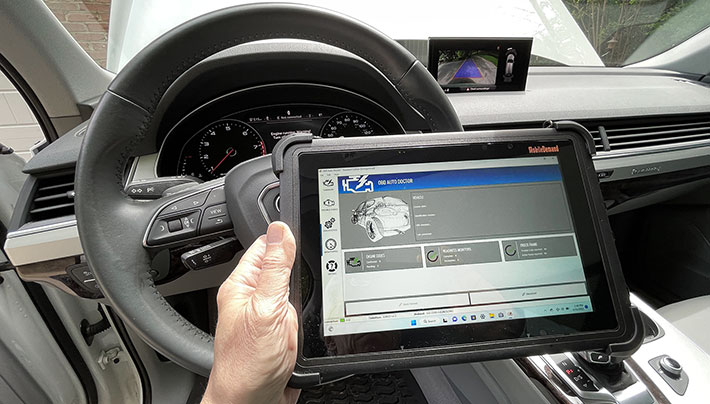
MobileDemand's 11xx class of rugged tablets
In the past, MobileDemand had at times followed one of Intel's marketing strategies. Just like Intel declared its Core i3, i5, and i7 processors to be "good — better — best," MobileDemand, too, had a good/better/best lineup with each level a step up in terms of performance, functionality, ruggedness and features from the one below. The current tablet lineup is different. The Flex 10 does remain as a low cost entry, and MobileDemand sells many case/product bundles, but the four 11xx class tablets are fairly close in design, features and price. The table below shows how the four compare:
|
MobileDemand Model
|
xTablet T1110
|
xTablet T1180
|
xTablet T1185
|
xTablet T1190
|
|
Display (inches/resolution)
|
10.1/1280 x 800, 149 ppi
|
10.1/1920 x 1200, 224 ppi
|
10.1/1920 x 1200, 224 ppi
|
10.1/1280 x 1200, 224 ppi
|
|
Luminance
|
500 nits
|
550 nits
|
550 nits
|
800 nits
|
|
Size (inches)
|
10.78 x 7.44 x 0.59
|
11.2 x 7.56 x 0.87
|
11.2 x 7.56 x 0.87
|
10.5 x 7.14 x 0.59
|
|
Starting weight
|
2.19 lbs
|
2.64 lbs
|
3.24 lbs
|
2.30 lbs
|
|
Processor Type
|
Intel Pentium N6415
|
Intel Core i5-8200Y
|
Intel Pentium N6415
|
Intel Celeron N4120
|
|
RAM
|
8GB LPDDR4
|
8GB LPDDR3
|
8GB LPDDR4
|
8GB LPDDR4
|
|
Storage
|
256GB M.2 PCIe NVMe SSD
|
256/512GB M.2 PCIe NVMe SSD
|
256GB M.2 SSD
|
128GB eMMC
|
|
Sealing
|
IP65
|
IP65
|
IP65
|
IP65
|
|
Operating temp.
|
14° to 140°F
|
14° to 122°F
|
14° to 122°F
|
14° to 122°F
|
|
Drop
|
5 feet
|
5 feet
|
5 feet
|
5 feet
|
|
Scanner
|
opt. Honeywell N4680
|
opt. Honeywell N6703
|
opt. Honeywell N6703
|
opt. Honeywell N6703
|
|
USB-A port
|
Yes (1)
|
Yes (2)
|
Yes (2)
|
Yes
|
|
USB-C port
|
Yes (2)
|
No
|
No
|
Yes
|
|
RJ45 LAN
|
No
|
Yes
|
Yes
|
Yes
|
|
GPS
|
Yes (uBlox M8N/M9N
|
Yes (uBlox M8N)
|
Yes (uBlox M9N)
|
Yes (uBlox M8N)
|
|
Battery
|
43 whr ("up to 12 hours")
|
68 whr ("up to 10 hours")
|
68 whr ("up to 10 hours")
|
36.5 whr ("up to 9 hours")
|
|
Cameras
|
2mp/8mp
|
2mp/8mp
|
2mp/8mp
|
2mp/8mp
|
|
3D camera
|
No
|
optional
|
optional
|
No
|
|
HDMI
|
No
|
micro
|
micro
|
micro
|
|
WWAN
|
No
|
No
|
optional
|
optional
|
|
Price
|
TBA
|
from US$2,415
|
from US$2,095
|
from US$2,120
|
Perusing this table, one might get the impression that there really isn't much of a difference between the quartet. While the MSRP of the just released (late April 2023) T1110 hasn't been revealed as of this writing, the other three are priced fairly close to each other, generally starting in the low $2,000s. So let's take a look at the differences between these four rugged 10-inch tablet PCs.
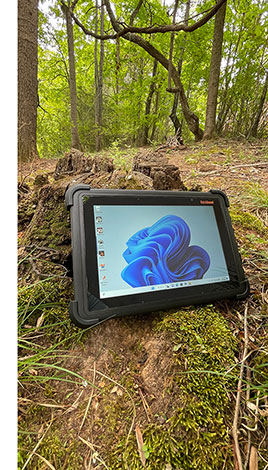 The size, resolution, and brightness of the LCD display matters more than almost anything else in a tablets. Here, the newly released T1110 has lower 1280 x 800 pixel resolution than the others' 1920 x 1200. That means a significantly lower pixel density in the T1110, something that may or may not matter, but definitely should be considered. The size, resolution, and brightness of the LCD display matters more than almost anything else in a tablets. Here, the newly released T1110 has lower 1280 x 800 pixel resolution than the others' 1920 x 1200. That means a significantly lower pixel density in the T1110, something that may or may not matter, but definitely should be considered.
Display brightness is very important for outdoor work. Here, the T1190 offers 800 nits of luminance whereas the other three are in the 500 nits range. 500 is average for premium tablets, whereas 800 really helps with outdoor work.
MobileDemand has never participated in the "horsepower race" taking place in the premium ultra-rugged tablet sector, instead opting for a good balance between cost and performance. Here, three of the four use higher-end Intel Atom-class processors, whereas the T1180 has a genuine Core processor. Technically, that puts the T1180 into a higher performance level than the others, but progress in processor technology has greatly reduced the power of new high-end Atom chips vs low-end Core chips.
Not everyone realizes that the type of storage technology matters almost as much as processor performance, and sometimes more. Here, the new T1110 comes with blazingly fast PCIe NVMe storage, the T1180 and T1185 with very quick SATA storage, and the older T1190 with much slower board-mounted MMC storage.
Though the T1190 is older, it does have a USB-C port, and the new T1110 has two of them. USB-C is the future, is very versatile, and it's something that's missing from the T118x models. That can make a difference. Cameras are largely the same, but the Intel RealSense 3D camera option is only available with the T118x models. RealSense offered intriguing new functionality, but Intel seems to have dropped the technology, so we're not sure where that stands. All four offer optional integrated 1D/2D scanners, with the new T1110 using the Honeywell N4680 and the other three the older Honeywell N670X.
More battery power is generally better, but it also means higher weight. MobileDemand quotes battery life up to 9 to 12 hours for all models, which is full-shift, and thus acceptable.
In terms of ruggedness, all four are in pretty much the same class. All offer IP65 ingress protection, 5-foot drop resistance, great tumble test results and steel ball drop resistance, and a very wide operating temperature resistance.
xTablet T1185: MobileDemand's "value and performance" tablet
In almost all respects, the xTablet T1185, introduced late 2022, is the successor of the xTablet T1180. In its marketing materials, MobileDemand tagged the T1180 as a "jack of all trades," whereas the new T1185 highlights "value and performance." From what we can tell, the two models are nearly identical in design expect for their processor and some details, so the change in language may come from the switch from an older low-end Core processor to a newer high-end Atom processor.
First impression matters, and the xTablet T1185 certainly makes a very good one. Whereas the considerably less costly Flex 10B is a generic tablet in a case, the T1185 is a true rugged tablet design both inside and out. It looks and feels like a serious tool for the job, a rugged tablet that was designed from the ground up to handle the bumps and grind and drops that come with work in the field.
There are hefty bumpers on all four corners, the kind that aren't just design elements but clearly afford true real-word protection. There are all the doors, compartments, locks, hooks, loops and attachment and mounting points and details that one expects from a rugged tablet. There's nothing wrong with the gleaming etherial sleekness of premium consumer tablets, but those are detriments out there on the job where the rubber meets the road. With the xTablet T1185, form follows function, not fashion.

Despite being in the same 10-inch display class as the standard Apple iPad, as a rugged tablet the T1185 is larger and heftier. Some of that extra heft and size is due to a good deal of built-in protection, another to the presence of ports and integrated functionality. The display's 16:10 aspect ratio is pleasant to our eyes, between the iPad's squarish 4:3 and the narrow (or wide, depending on whether you use them in landscape or portrait mode) 16:9 aspect ratio favored by many non-Apple tablets. The xTablet T1185 looks large enough for real Microsoft Windows work.
One look at the xTablet T1185 is also enough to realize that this is a rugged machine and not something retrofitted for extra duty. The designers skillfully combined the contemporary tablet look with the functionality and features required of a rugged tablet. Most consumer smartphones and tablets these days have displays taking up the entire front of a device. That makes them damage-prone and such displays really aren't very practical. The T1185, on the other hand, has a nice margin around the actual display that's large enough to a) allow for a flush front glass surface for easy touch operation, and b) allows for easy holding of the tablet without blocking part of the LCD. The actual LCD is recessed a bit from the housing bezel, just enough for MobileDemand to apply a fairly thick screen protector.
Below is a look at the xTablet T1185 from the front and from all four sides with all of its protective doors closed. The pictures clearly show the tablet's robust, functional design.
Along the top side of the display are the on/off/sleep button and a volume up/down rocker. A protected standard 3.5mm audio port is there, as well as loops for the carry handle, indents for us with a vehicle dock, screw holes for attaching optional modules, and the scanner window. The front view shows the ambient light sensor and two alignment markers for inserting the tablet into a dock. A small, but very valuable detail.
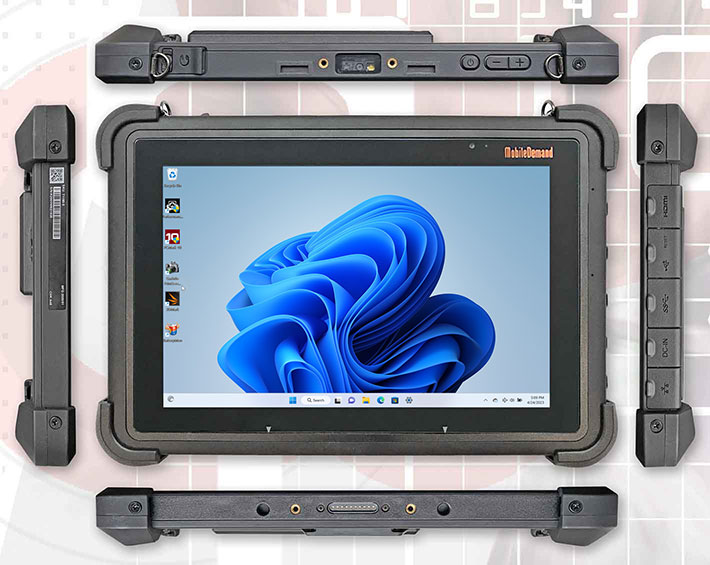
On the bottom is the unit's surface mount docking connector, flanked by two holes used for secure mounting on one of the docking options. With the exception of the audio jack, all I/O is on the right side of the tablet, with each I/O port having its own separate protective rubber/plastic door. The doors provide a good, tight seal. They are also easy to open and press shut. That should be mandatory on all rugged devices, but we've seen many that are hard to close and open.
The close-up below shows the right side of the tablet with the (replaceable) protective doors photoshopped out of the way for better viewing of the xTablet T1185's ports. From left to right, there's an RJ45 LAN jack, power, two USB 3.0 ports, and a micro HDMI port. The T1185 doesn't have an onboard serial port and some customers may miss that. What we do miss in a current-er machine is a USB-C port or two.

Note that the xTablet T1185 doesn't have (nor need) a fan. It operates silently and that can be a big plus in an office setting and many other areas where air disturbance is a negative (such as in healthcare or certain manufacturing). And not having a fan means not having to worry about a mechanical component that can get clogged up or fail.
Designed to be tough and rugged
Unlike the company's entry-level Flex tablets that embed consumer tablets in rugged protective shells, the xTablet T1185 is designed and built from scratch as a very rugged system. It's a well sealed unit that doesn't require a case to hold up under extreme conditions.
The difference between a plain vanilla consumer design and rugged machinery is already evident in the pictures below. While most of today's consumer tablets can't even be opened anymore, the xTablet T1185 has no fewer than four externally accessible openings that allow customization with various modules and components. The battery, too, can easily be replaced. And there's a snap-mount anchor for quick insertion and removal into mounting systems.
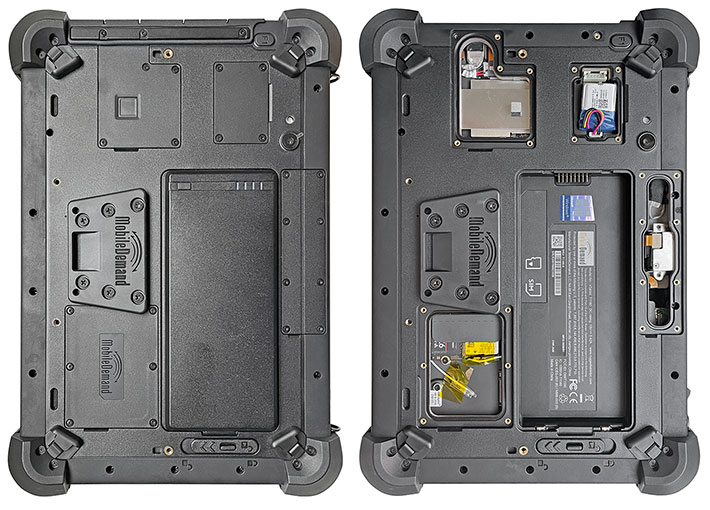
In terms of construction, the xTablet T1185 consists of a polycarbonate plastic housing with an internal magnesium chassis that's screwed onto the front part of the housing. Mounted on the chassis are the LCD on one side and motherboard, components and modules on the other. The front part of the housing is implemented as a shallow open box. The flat rear part is covered in many areas for reinforcement.
Should the need arise to open up the tablet, remove the four bumper assemblies, undo some 16 small Philips screws and separate the halves. With the exception of the small 0.59 watt-hour hot-swap battery that plugs into the motherboard, there are no cables or ribbons between the two halves. Below you can see what the xTablet T1185 looks like inside:
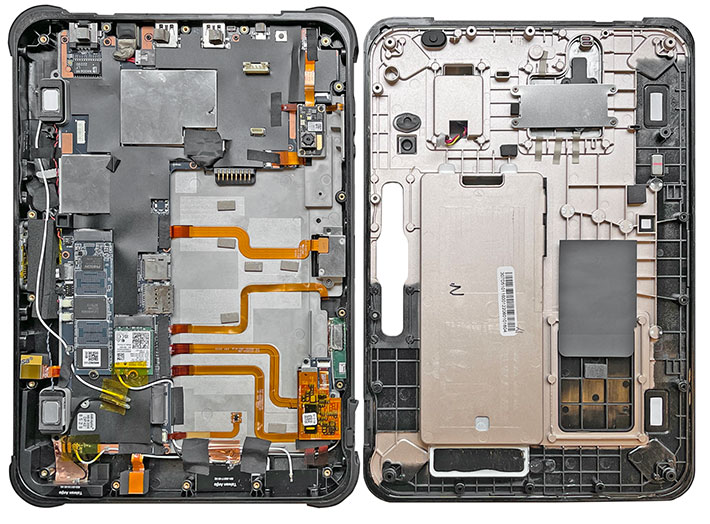
Sealing between the two parts of the housing is of a tongue-and-groove design, with a hard plastic lip on the front part of the housing pressing against a replaceable o-ring seal sitting inside a groove around the perimeter of the backplate.
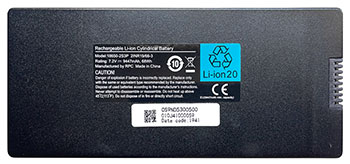 The big 68 watt-hour rechargeable Li-Ion battery of the T1185 snaps into its compartment, but doesn't fit flush like the 40 watt-hour pack that was standard on prior versions of the platform. The battery has its own friction seal, which is necessary as the battery compartment includes not only the battery terminal openings into the interior of the tablet, but also openings for the unit's microSD and micro SIM slots. The big 68 watt-hour rechargeable Li-Ion battery of the T1185 snaps into its compartment, but doesn't fit flush like the 40 watt-hour pack that was standard on prior versions of the platform. The battery has its own friction seal, which is necessary as the battery compartment includes not only the battery terminal openings into the interior of the tablet, but also openings for the unit's microSD and micro SIM slots.
The battery is secured in place with a spring-loaded lever that can be locked in place. The battery, which is hot-swappable, is unlikely to come loose during operation.
Unlike the interior of many Windows tablets, which are jam-packed full of electronics, the T1185 looks remarkably tidy inside. The L-shaped motherboard is much larger than inside earlier Intel Atom-based version of the tablet. Much of the board is covered up with black foil, and a number of circuits sit underneath EMI shielding.
There's a half-size mini PCIe slot for a mobile broadband module. Antennae and their wiring is already pre-installed. WiFi and Bluetooth are handled via an Intel 9260NGW module. Almost all I/O is edge-mounted on the motherboard, exceptions being the surface-mount docking connector and the standard 3.5mm audio jack. This is a very highly integrated and very professionally executed design.
The interior layout is visually dominated by various miniaturized ribbon cables that connect the motherboard to all the antennae, cameras, speakers, and other things mounted inside the T1185. The two speakers, the 1D/2D barcode scanner and the camera module all have their own separate cubbies on the Magnesium chassis of the tablet.
As for as protection goes, each of the tablet's peripheral port openings has its own separate protective door with a friction seal. These individual port covers are actually all cut from one single piece of rubbery material, which can easily be replaced. For drop/bump protection, the plastic housing itself has a rubbery protective layer that goes around the entire perimeter of the tablet, and also has small integrated corner bumpers. These bumper areas contain anchors for larger protective bumpers that screw on. If the extra protection afforded by the heavy duty anchors is not needed, they can be taken off and the tablet can be used without them, making for a smaller footprint.
Shown below are a few of interesting details of the xTablet T1185. On the left the tablet's tiny camera and LED illuminator snuggly sitting in their own cubby in the metal chassis. In the middle the two-part protective corner bumpers that are individually replaceable. On the right a closeup of the T1185's 1D/2D industrial grade barcode reader. Sure, there are smartphone apps that can read barcodes with the phone camera. Having a dedicated scanner is much faster and much more accurate.

And more details below: On the left the slots for the tablet's micro SIM and micro SD card. So the battery must be removed to get at those slots and they represent additional openings to the interior. Not ideal. In the middle the small battery that makes hot-swapping of the main battery possible. And on the right a look at the replaceable seal between the two housing halves. The seal is not too complex, and should work well.

Overall, the insides of the xTablet T1185 show a complete, powerful PC stuffed into a small space, but much of the componentry and electronics have been miniaturized more like those in a consumer tablet. Quality is very high, with good fit and finish.
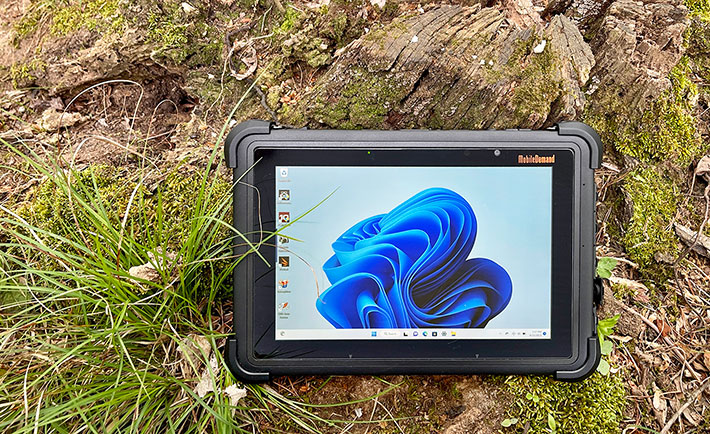
Solid performance
The xTablet T1185 runs Windows 11 Professional (an optional downgrade to Windows 10 Pro is available) on an Intel "Elkhart Lake" Pentium N6415 processor. "Elkhart Lake" is Intel's code name for a line of processors that, while based on an Intel Atom architecture that's simple compared to the high-end Intel Core architectures, were enhanced to, so says Intel, meet the specific needs of IoT — Internet of Things — "edge" devices.
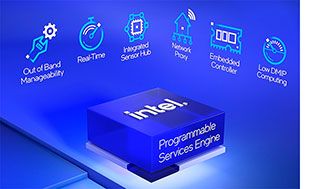 What does "edge" mean in this context? "Edge computing" refers to using technology at the edge of the ever-growing range of networks. That includes systems on the road, in the field, and in everyday situations, which includes electronic payments, point of sale systems, and other retail, field, logistics and manufacturing deployments that tablets like the T1185 were designed for. What does "edge" mean in this context? "Edge computing" refers to using technology at the edge of the ever-growing range of networks. That includes systems on the road, in the field, and in everyday situations, which includes electronic payments, point of sale systems, and other retail, field, logistics and manufacturing deployments that tablets like the T1185 were designed for.
The growing importance of all that processing performed at the outermost levels of network requires more connectivity, more bandwidth, and higher levels of security enabled right through new generations of processors, and that was what the Elkhart processor platform was designed to support.
Naming is a little confusing there because Intel has been using the "Pentium" brand for budget-friendly lower end Core processors for a years, but has lately begun using it both for high-end Atom-class processors as well. The Pentium N6415 that's used in the T1185 is of the latter variety. It is a modern quad-core 10nm design with an economical 1.2GHz base frequency, but also allows bursts all the way up to 3.00 GHz. Thermal Design Power is an economical 6.5 watt, generating far less heat than modern Core processors.
As is, the table below shows our benchmark results for the MobileDemand xTablet T1185, the xTablet T1180 and T1190, as well as some other rugged 10-inch class tablets that we've reviewed and tested in our lab.
|
MobileDemand T1185 vs 10-inch class rugged tablets
|
|
Company
|
Mobile Demand
|
Mobile Demand
|
Mobile Demand
|
Estone
|
Getac
|
Ruggon
|
Zebra
|
|
Model
|
T1185
|
T1180
|
T1190
|
MJC-100
|
UX10
|
PX501
|
L10
|
|
Year tested
|
2022
|
2018
|
2021
|
2019
|
2021
|
2018
|
2018
|
|
CPU Type
|
Pentium
|
Core
|
Celeron
|
Atom
|
Core
|
Core
|
Core
|
|
CPU model
|
N6415
|
i5-8200Y
|
N4120
|
x5-Z8350
|
i7-10510U
|
i5-7300Ue
|
i7-8650U
|
|
Display size
|
10.1-inch
|
10.1-inch
|
10.1-inch
|
10.1-inch
|
10.1-inch
|
10.1-inch
|
10.1-inch
|
|
Resolution
|
1920 x 1200
|
1920 x 1200
|
1920 x 1200
|
1920 x 1200
|
1920 x 1200
|
1920 x 1200
|
1920 x 1200
|
|
Luminance
|
476 nits
|
496 nits
|
750 nits
|
425 nits
|
1004 nits
|
NA
|
NA
|
|
Footprint
|
11.16 x 7.56
|
11.16 x 7.56
|
11.16 x 7.56
|
10.8 x 7.6
|
10.8 x 7.5
|
11.0 x 7.7
|
11.1 x 7.7
|
|
Thickness
|
0.87
|
0.87
|
0.87
|
0.74
|
0.88
|
0.90
|
0.88
|
|
Volume (cu-in)
|
73.4
|
73.4
|
73.4
|
60.7
|
71.3
|
76.3
|
75.2
|
|
Weight (lbs.)
|
3.24
|
2.64
|
2.30
|
2.00
|
2.68
|
3.00
|
2.90
|
|
Operating temp
|
-20° to 122° F
|
-20° to 122° F
|
-20° to 122° F
|
32° to 113° F
|
-20° to 145° F
|
-4° to 140° F
|
-4° to 140° F
|
|
IP rating
|
IP65
|
IP65
|
IP65
|
IP65
|
IP65
|
IP65
|
IP65
|
|
PassMark 6.1
|
3,375
|
3,061
|
2,188
|
694
|
6,627
|
2,497
|
5,963
|
|
PassMark 9.0
|
1,725
|
2,387
|
1,254
|
657
|
3,869
|
2,861
|
3,609
|
|
CrystalMark
|
196,002
|
200,021
|
159,187
|
NA
|
315,866
|
222,361
|
226,276
|
|
PCMark 10
|
2,140
|
NA
|
1,731
|
NA
|
3,869
|
NA
|
NA
|
|
3DMark TimeSpy
|
178
|
NA
|
139
|
NA
|
414
|
NA
|
NA
|
|
GeekBench 5 S
|
644
|
NA
|
438
|
NA
|
1,123
|
NA
|
NA
|
|
GeekBench 5 M
|
1,419
|
NA
|
1,511
|
NA
|
2,839
|
NA
|
NA
|
The results in the above table should not be read as what is better or worse. Different processors and setups have different performance characteristics and different costs. Each has its application and purpose. What we're showing here is how different types and generations of processors and technologies impact bottomline benchmark performance.
As far as the MobileDemand T11xx trio goes, there's a relatively small performance gap between the units, even though each uses a different processor class. But even here, Core tops Pentium, Pentium tops Celeron, and Celeron tops Atom. Even the by now aging Core CPU in the 1180 is still holding its own against the late-model "Elkhart" chip in the 1185.
Looking past the MobileDemand trio, note how it's a good thing to stay away from lowest-level processors. We've seen too many Intel Atom-based devices whose barely adequate performance was quickly overwhelmed by the next Windows upgrade. And note how even rather old Core chips several generations behind the current state-of-the-art remain competent performers. Finally, note how systems based on recent (costly) high-end mobile Core processors, such as the ultra-rugged Getac UX10, will simply leave anything else behind.
As is, MobileDemand chose wisely by equipping its tablets with "value and performance" chips that get the job done for years to come, without busting budgets.
Battery life
Battery size, weight and life are of major importance in tablet PCs, especially in devices that need to be as light and handy as possible. Battery technology has improved substantially, but not as quickly as processor and storage technology. The original Apple iPad set a standard with its 10-hour battery life. Ten hours gets you through a day. And what's even more important in work settings, it get you through a shift and then some.
MobileDemand is aware of that, and all of the T118x tablets are designed to run at least eight hours on a charge. To make sure of that, the T1185 comes with a beefy 68 watt-hour battery, for which the company claims up to ten hours of life between charges. We tested the xTablet T1185 with PassMark's BatteryMon utility and found the following:
|
MobileDemand xTablet T1185 Power Draws (at idle)
|
|
Backlight level
|
0%
|
50%
|
100%
|
|
Power Saver
|
4.8 watts (14.2 hrs)
|
5.9 watts (11.5 hrs)
|
7.2 watts (9.4 hrs)
|
|
Max Performance
|
5.4 watts (12.6 hrs)
|
6.5 watts (10.5 hrs)
|
7.5 watts (9.1 hrs)
|
With the tablet set to the Windows "Best battery life" mode and the display backlight set to its lowest, we saw a power draw of 4.8 watts. With the backlight set to medium, we saw 5.9 watts, and with the backlight set to its brightest setting, power draw rose to 7.2 watts.
In the Windows "Best performance" setting, we found a low of 5.4 watts at the lowest backlight setting, 6.5 watt with average backlight, and 7.5 watts with the backlight at its highest.
What does that mean? Well, divide the 68 watt-hours of the battery by the minimum power saver draw of 4.8 watts and you get a theoretical battery life of 14.2 hours. And divide the 68 watt-hours by the highest max performance draw of 7.5 watts, and theoretical battery life drops to 9.1 hours.
These number suggest that the xTablet T1185 should meet and perhaps exceed MobileDemand's estimate. Actual on-the-job battery life, of course, varies on how the tablet is being used.
What's interesting, though, is that both the T1180 and the T1190 showed lower draws in the BatMon drawndown test. There's an explanation for both: The Celeron chip in the T1190 has a slightly lower thermal design power than the Pentium CPU in the T1185. And the i5-8200Y in the T1180 benefits from the significantly more elaborate power saving technologies built into Intel Core processors.
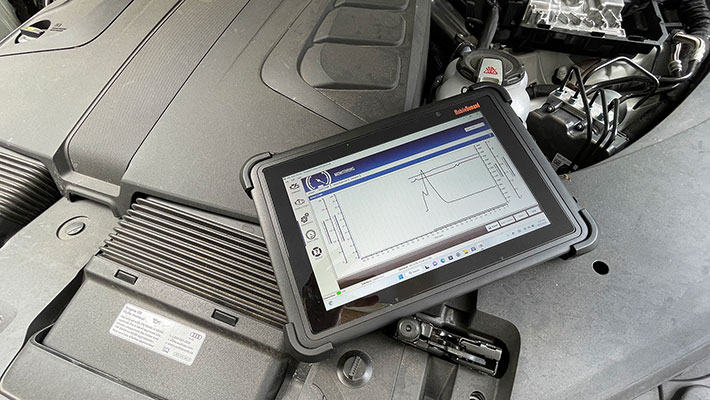
Very good 1920 x 1200 pixel capacitive multi-touch display
While MobileDemand has made a name for itself for providing good rugged tablet technology and tablet solutions at affordable prices, the company's efforts to make those low prices possible has never come at the expense of features that matter most to their customers. If an inexpensive processor gets the job done, MobileDemand won't spend 15 times as much on a high-end Core processor. If, however, high performance is required, they go for the very best and latest. Makes sense. And they will never skimp when it comes to displays. A good display is crucial for work out there in the field.
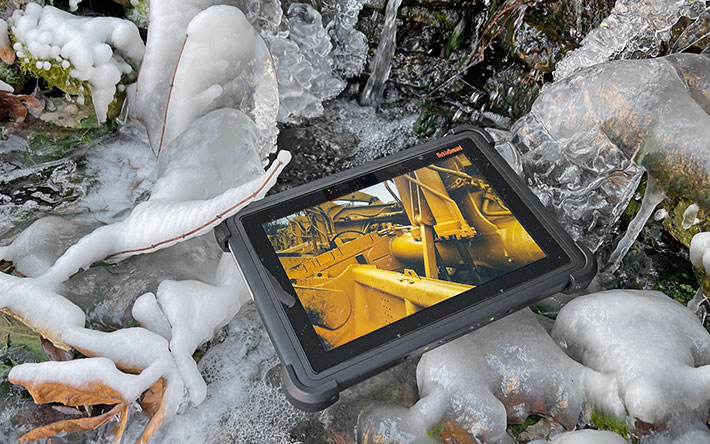
So it's no surprise that the xTablet T1185 has a very good display. Measuring 10.1 inches diagonally it's better suited for serious Microsoft Windows-based work than smaller tablets. It offers 1920 x 1200 pixel resolution in 16:10 wide-format. That's three times as many pixels as the 1024 x 768 XGA format that was commonly used in rugged tablets (even ones with larger screen sizes) for many years.
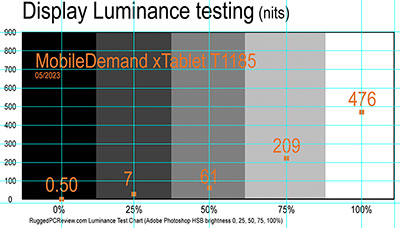 On a 10.1-inch tablet screen, 1920 x 1200 translates into 224 points per inch (ppi), which is in the range that Apple declared as "retina" — pixels so small that the eye can't distinguish individual pixels. That means even small text looks very sharp and crisp on the display. The xTablet T1185 uses 10-point projected capacitive multi-touch for effortless tapping, panning, pinching and zooming. Using Microsoft Windows on very small touch screens can be a challenge. It's less of an issue on a larger display like the T1185's, and Windows 11 is better suited to capacitive touch than its predecessors. On a 10.1-inch tablet screen, 1920 x 1200 translates into 224 points per inch (ppi), which is in the range that Apple declared as "retina" — pixels so small that the eye can't distinguish individual pixels. That means even small text looks very sharp and crisp on the display. The xTablet T1185 uses 10-point projected capacitive multi-touch for effortless tapping, panning, pinching and zooming. Using Microsoft Windows on very small touch screens can be a challenge. It's less of an issue on a larger display like the T1185's, and Windows 11 is better suited to capacitive touch than its predecessors.
In daily use, the display works very well. The spec sheet claims 550 nits luminance. We measured 476, which may be due to the T1185's screen protector. To put that in perspective, most standard laptops offer around 250 nits, premium tablets are generally in the 500 nits range, and displays specially built to use in sunlight may have over 1,000 nits. Subjectively, the T1185 screen is nice and bright, and very vibrant indoors. Outdoors, of course, perceived brightness depends on how bright it is outdoors on any given day and working condition.
The three pictures below show what you can expect outdoors from the T1185. The picture on the left was taken on a bright sunshiny day in the shade. That way, the display looks bright and offers very good contrast. The middle picture shows the impact of refection. Like almost all modern tablets, the T1185 has a glossy display surface. Depending on how the tablet is positioned, there will be reflections. The picture to the right shows the tablet reflecting the blue sky. The T1185 is bright enough to handle outdoors, but, just as with any modern handheld or tablet, one needs to avoid reflections. If that is an issue, MobileDemand offers an anti-glare screen protector.

We cannot overemphasize how important a wide viewing angle is for a satisfying, non-disruptive viewing experience. Older and lesser display technologies are prone to often dramatic color and contrast shifts when viewed from different angles, something that we don't consider acceptable anymore. The xTablet T1185's display is immune to such shifts, which makes it a pleasure to use.
Bottom line here is that the T1185's designers did a good job selecting this display. One thing we weren't able to find out is whether there is an optional active digitizer for this tablet. Those still come in handy for applications that require more precise control than is possible with fingers or a passive capacitive stylus.
Decent dual cameras
The xTablet T1185 has two integrated cameras. The user-facing 2mp camera is for video conferencing, whereas the rear-facing 8mp camera with LED flash can be used for documentation purposes.
Cameras integrated into handheld and tablet computers have historically underperformed compared to even low-end dedicated cameras and, more recently, the cameras available in virtually every smartphone. Things have gotten better on the built-in camera front, 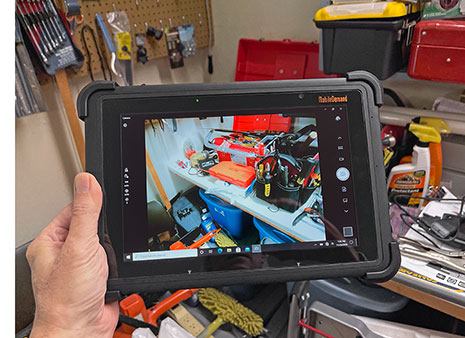 but usually not enough to eliminate the need of taking along a dedicated camera or smartphone if photo or video documentation is needed on the job. This remains a concern given that the cameras in leading smartphones are now capable of excellent picture and video quality. but usually not enough to eliminate the need of taking along a dedicated camera or smartphone if photo or video documentation is needed on the job. This remains a concern given that the cameras in leading smartphones are now capable of excellent picture and video quality.
When we reviewed a predecessor of the T1185, the xTablet T1150, a good while ago, we mentioned that due to the absolutely barebones Windows Camera app we couldn't really test all the settings and capabilities of the tablet's camera hardware. The Windows Camera app version in the T1185 offered more options — including a "pro mode" with exposure setting, white balance settings, and manual focus — though system integrators and many customers might still miss all the many features available in smartphone cameras these days.
When using the cameras, the documentation camera offers seven different still image resolutions ranging from 0.4mp to the full 8.0mp, and users can shoot video in four resolutions ranging from 480p to 1080p, all at 30 frames per second. In still photography, auto-focus worked fine, images were surprisingly crisp and sharp, and the camera does not over-compress images. Video was sharp enough for almost all purposes and did not lag behind. It pays to take time shooting pictures as there's a slight lag between pressing the shutter and the image being taken.
The front camera, offers seven still image resolutions ranging from 0.03mp to 1.9mp, and six video resolutions, from 120p to 720p. It worked well enough for conferencing.
Below are pictures shot with the xTablet T1185 documentation camera in 3264 x 2448 pixel resolution. To see a full-size image of the compilation, click on the picture.
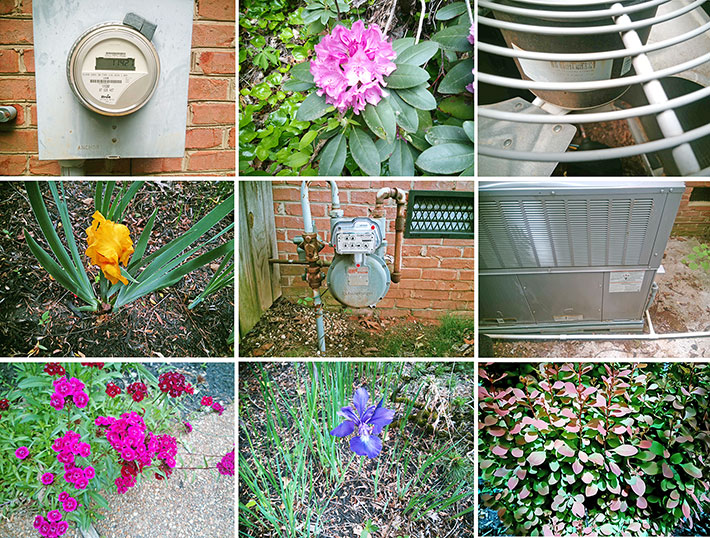
Like we found in our testing of earlier MobileDemand rugged tablets, the T1185's integrated documentation camera is suitable for most documentation tasks, both in still shots and in video. It's nice to have the big 10-inch screen as a viewfinder. Pictures actually come out a lot sharper than they appear on the screen.
That said, the problem is that smartphone cameras have become so very good and so competent. As a result, users expect the same from rugged handhelds and tablets, especially since those cameras should help them with their work and jobs.
That's not all there is to say about the T1185's integrated cameras. MobileDemand also offers an optional external Intel RealSense D455 Depth Camera with depth technology, probably the same or similar as in MobileDemand's older 8-inch xTablet T8650. We examined that camera in our xTablet T8650 review (see here). It's exciting. This would bring spatial awareness to the T1185, and that can be used for an emerging range of very interesting and productivity-enhancing 3D measuring applications
Tough enough for the job
The major reason why customers opt for a rugged tablet is, obviously, ruggedness. The tablet must be able to handle the inevitable bumps and grinds and exposure on the job. What can you expect from the T1185?
As far as the ever important drop spec goes, the T1185 exceeds the MIL-STD 810G, 516.6 IV gold standard that mandates 26 repeated drops to one operating unit onto plywood over concrete from 48 inches. Why 48 inches? Because if a tablet is dropped while it's being used in a standing or walking position, it'll drop about four feet. The xTablet T1185 can actually handle those drops from five feet. Kudos.
The operating temperature range is 14° to 122°F, which covers most potential applications out there.
The biggest difference between the xTablet T118x models and the lower-end xTablet Flex 10B is in the sealing of the units against the elements. Despite its protective casing and nicely implemented protective rubber plug for all I/O ports, the Flex 10B isn't considered a sealed unit and does not have an ingress protection rating. That means no working in the rain. The xTablet T1185, on the other hand, carries a respectable IP65 rating. That means they're totally dustproof and can also handle low pressure water jets from all directions. That'll do for virtually all deployments.
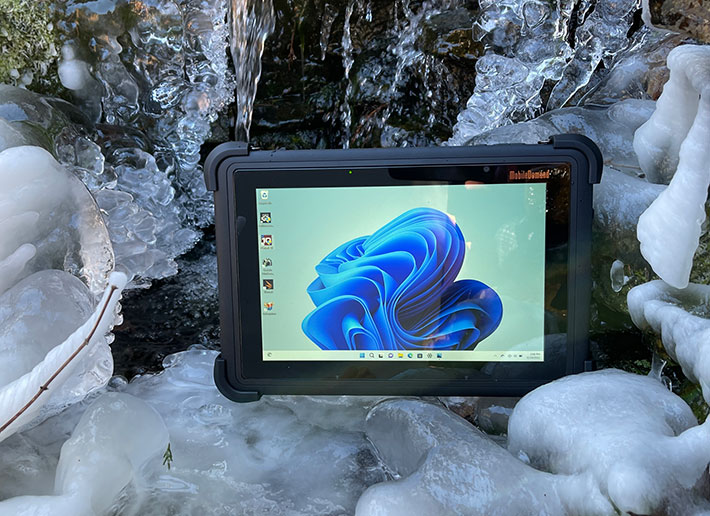
Given the T1185's exemplary build and obvious toughness, the specs don't show all that much in terms of ruggedness information. Given that the T1185 is a rugged tablet and is sold as one, we'd like to see more comprehensive testing results, even if just via a web link.
Mounting and docking options
Most tablets used in business or on the job come with some kind of docking and mounting options, and the xTablet T1185 is no different. Available are a desktop docking station, a vehicle dock, and very handy quick-release mounting options.

We had a chance to test the available heavy-duty RAM Mount setup and loved it. Flimsy mounting options can be quite frustrating due to vibrations and flex. No such problems with this setup. Super-easy to adjust any which way (see below), and absolutely solid as a rock. Highly recommended.

Bottom line: MobileDemand xTablet T1185
With the xTablet T1185, MobileDemand offers, in essence, an updated version of its popular T1180 rugged tablet. With a modern Intel "Elkhart" processor, the T1185 offers performance comparable to the predecessor T1180 with its hotter-running and more expensive Core processor.
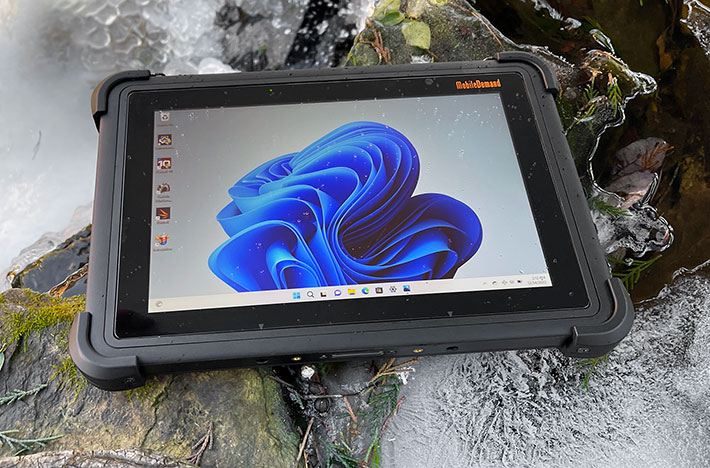
Like its three T11xx siblings, the xTablet T1185 was designed from the ground up as a rugged tablet. It can be equipped with an integrated industrial-grade scanner, dedicated GPS, as well as an Intel 3D RealSense camera option for an emerging range of productivity-enhancing Depth and LiDAR-based 3D measuring applications.
Weighing in at about 3.2 pounds, MobileDemand's xTablet T1185 provides an attractive proposition for customers who want the convenience and ease of use of a 10-inch class tablet in package that's well-equipped and well-protected but costs less than premium rugged tablets.
The tablet's new "Elkhart Lake" processor provides good performance while generating so little heat that a noisy and potentially troublesome fan wasn't necessary.
The xTablet T1185 impresses with a crisp, sharp, bright and vibrant 10.1-inch 1920 x 1200 pixel display with perfect viewing angle from all directions and no color or contrast shifts. Its 10-point capacitive multi-touch screen is quick and very responsive, and works very well with Windows 11 and touch-optimized applications.
Onboard connectivity including two full-size USB 3.0 ports (unfortunately not a USB-C port), micro-HDMI, and an RJ45 LAN jack. The 2mp and 8mp cameras are suitable for conferencing and documentation. There is a powerful user-accessible 68 watt-hour main battery and a replaceable hot-swappable battery.
The tablet's rubber and polycarbonate casing is well designed and of high quality. Protective bumpers and port plugs are effective and can easily be replaced. The tablet is well sealed, can survive steep drops unharmed, and the operating temperature range of the tablet is wide enough for virtually any application.
All of this makes the fanless xTablet T1185 a compelling rugged tablet option that nicely balances value and performance. It's for anyone who needs Windows on tough jobs, even those that require high-level sealing, high resolution, GPS, and industrial-grade scanning.
-- Conrad H. Blickenstorfer, May 2023
MobileDemand xTablet T1185
| Type
|
Rugged tablet computer
|
| Added |
Full review 05/2023
|
| Processor |
Quad-core Intel "Elkhart Lake" Pentium N6415
|
| Processor speed |
1.20GHz, 3.00GHz maximum burst frequency
|
| Thermal Design Power |
6.5 watts |
| Graphics |
Intel UHD Graphics for 10th Gen Intel Processors, 350-800MHz
|
| OS |
Windows 11 Pro, optional: Windows 10 Pro Downgrade; LTSC |
| Memory |
8GB LPDDR4 |
| Storage |
256GB M.2 PCIe NVMe solid state disk, up to 1TB on SDXC card |
| Expansion slots |
1 x micro SDXC card, 1 x microSIM |
| Display |
TFT IPS LCD, oleophobic, scratch-resistant glass |
| Display size/res |
10.1-inch, 1920 x 1200 pixel, 550 nits (476 measured)
|
| Digitizer |
10-point capacitive multi-touch with stylus, glove and wet-touch support |
| Keyboard |
Onscreen keyboard + optional external
|
| Housing |
Polycarbonate housing with integrated and replaceable protective rubber bumpers, magnesium internal frame |
| Size |
11.16 x 7.56 x 0.87 inches (295 x 192 x 22 mm)
|
| Weight |
3.24 lbs in base config; 52.5 oz. as tested fully loaded
|
| Operating temperature |
14° to 122°F (-10° to 50°C)
|
| Ingress protection |
IP65
|
| Drop/shock |
MIL-STD 810G, 516.6 IV: 26 repeated drops to one operating unit onto plywood over concrete from 60 inches
|
| Vibration |
Unknown
|
| Tumble |
100 times x 1m tumbles
|
| Humidity |
95% non-condensing
|
| Power |
Rechargeable, replaceable 7.2V 9,450mAH 68 watt-hour Li-Ion ("up to 10 hrs")
|
| Cameras |
2mp camera front, 8mp AF camera with LED flash rear; optional Intel RealSense D455 3D camera |
| Sensors |
Accelerometer, eCompass, gyroscope, ambient light, proximity
|
| Interface |
2 x USB 3.0, 1 x micro HDMI, 1 x RJ45 LAN, 3.5mm headphone jack, power, docking |
| Wireless |
Intel AC 9260 802.11 a/b/g/n/ac WiFi, Bluetooth 5.1, uBlox NEO-M9N GPS; optional: NFC module, 1D/2D barcode reader, 4G LTE (Sierra Wireless EM-7565)
|
| Price |
On May 4, 2023, starting at $2,095
|
| Warranty |
3-year warranty that covers hardware failure when the tablet has been used as designed. Optional extended coverage with xProtect.
|
| Regulatory |
FCC-CE-IC-WEEE-RoHS-UKCA
|
| Web |
MobileDemand xTablet T1185 web page |
| Contact |
MobileDemand xTablet T1185 specs (PDF) |
(copyright 2023 RuggedPCReview.com)
|
|
|
|




